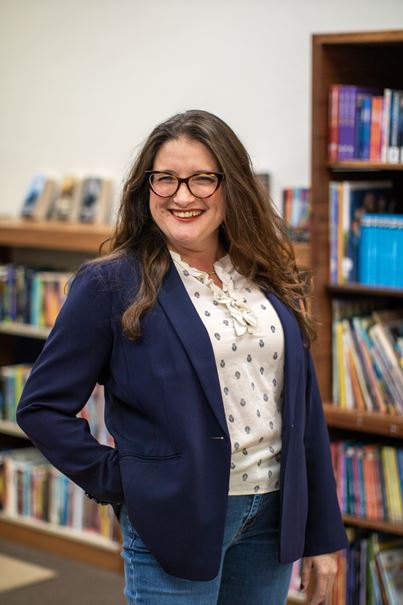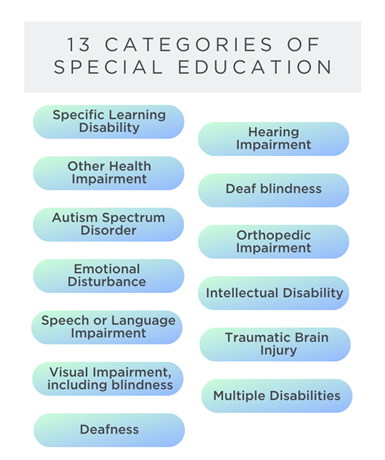 Katie Ramel, a Training Specialist at Cornerstones of Care, became an expert on IEPs in a somewhat unconventional way.
Katie Ramel, a Training Specialist at Cornerstones of Care, became an expert on IEPs in a somewhat unconventional way.
“My background was in medicine first, and that really informs my perspective,” said Katie.
Working in a small family practice, she often interacted with foster families during a child’s initial medical exam when they entered the foster care system. Her work in the medical field inspired an interest in brain science, and she saw first-hand how children and families were impacted by trauma.
Katie spent the next decade of her life in public schools teaching reading, science, and math to middle schoolers. It wasn’t long before her medical background came to the forefront of her work with kids struggling in the classroom.
“I discovered I connected with children struggling with regulation,” said Katie. “Because of my understanding of the brain and learning processes, I developed a very structured classroom with consistency, repetition, and a lot of spatial, auditory, and visual cues. I understood the importance of teaching to different modalities so I could reach a wider audience.”
Over time, kids with special needs were hand-selected to be in Katie’s classroom. Because of her skill in working with students with special needs, she was also asked to participate in many Individualized Education Program (IEP) teams to help determine how the school could support each student.
Today, Katie shares her expertise with teachers, parents, case managers, foster parents, and anyone who wants to learn how better to serve the needs of our youngest community members.
She also serves on the Center School District Board of Education, where she takes her passion for education to the policy level. In that setting, she advocates for funding for public education so that schools can be afforded the resources to meet the needs of students.
In this short interview, we ask Katie to answer a handful of questions about IEPs. At the end, we’ll connect you to additional resources to learn more about this topic.
What is an IEP, and how do you qualify for one?
“An IEP is a written document,” said Katie. “It outlines the strengths of the student, areas of improvement, and very specific goals. It also states how often those goals will be measured and what accommodations and modifications the school will make to ensure that the child has access to education in the least restrictive environment.” 
To qualify for an IEP, students must fit into one of thirteen categories outlined under the Individuals with Disabilities Education Act (IDEA). To be covered, the student’s school performance must be “adversely affected.” Categories include autism spectrum disorder, traumatic brain injury, deafness, and others.
Emotional Disturbance is also one of the 13 categories and often shows up in the population that Cornerstones of Care serves. Children who have experienced trauma, such as being removed from the home due to neglect or abuse, will develop mental health challenges, like anxiety disorder, depression, and post-traumatic stress disorder, that typically fall under Emotional Disturbance.
“Many of the children we serve in Residential Treatment, the Day Treatment schools, or Foster Care could qualify under Emotional Disturbance,” said Katie. “Trauma makes us more vulnerable to mental health concerns.”
What is a 504, and how are they different?
504 plans are covered by Section 504 of the Rehabilitation Act. It’s a civil rights law, which is different than an IEP but aims to provide access to education for individuals with disabilities.
IEPs are intended to provide individualized special education and services to meet a child’s unique needs. 504s provide support and remove barriers for a student with a disability. Section 504 has a broader definition of a disability than IDEA, which is why a child who doesn’t qualify for an IEP may still be able to access a 504.
“A 504 doesn’t offer the structure that an IEP does,” said Katie. “There are not set goals and regular measures; instead, it’s more of a document that outlines the accommodations that a person needs to have equal access to education.”
One significant advantage of a 504 is that it extends beyond schools and can support an individual with special needs throughout their life. And yes, children in schools can have both IEPs and 504s at the same time.
“I strongly encourage anyone who has a disability and qualifies for an IEP to have a 504 in place long before exiting K-12 education,” said Katie.
Who can advocate for an IEP?
The question of who can advocate for an IEP is tricky because it’s determined by individual states and school districts, not by an overarching national policy. One thing consistent across states is that the biological parent is always the person who can advocate for special education services for their child – unless parental rights have been terminated.
Parents and guardians are also the only individuals legally allowed to request or sign education documents, including a request for an IEP evaluation.
In Missouri, if parental rights are terminated, the school can designate an educational advocate.
“It could be a case worker, foster care placement, or a kinship placement,” said Katie. “In Kansas, there is one organization, Families Together, that assigns the educational advocate for the child.”
If someone in Kansas wants to be an educational advocate for a minor whose biological parents are unknown or unavailable, they can complete the free in-person training.
Even if an individual, such as a foster parent, does not complete the official training, they can still be invited to the IEP meetings to offer insight and support.
How can a guardian prepare for an IEP meeting?
When preparing for the first IEP meeting with other team members, Katie recommends taking some time to organize your thoughts.
 “Ask yourself: What are the child’s areas of strength and areas of weakness that you see?” said Katie. “Always enter the room with the right mindset and positive intentions. Remember that you are collaborating with others, and they might see something different than you. Have an idea of what accommodations you think might help the child.”
“Ask yourself: What are the child’s areas of strength and areas of weakness that you see?” said Katie. “Always enter the room with the right mindset and positive intentions. Remember that you are collaborating with others, and they might see something different than you. Have an idea of what accommodations you think might help the child.”
Creating an IEP is intended to be a collaborative process that requires input from individuals who know the child’s unique needs. The IEP team might include a teacher, a special education teacher, a school administrator, a counselor or social worker, and a parent or educational advocate. Often, documents will be brought in from outside services like a doctor or physician.
“I think it’s very important that we build a team around the children we serve. It is ideal when caseworkers, placement parents, and, if possible, biological parents are communicating,” said Katie.
At times, the process can feel messy. Still, the important part is remembering that everyone on the IEP team has the same goal: to work together to improve educational results and opportunities for children with disabilities.
And IEPs must be reevaluated regularly, so there is always an opportunity to modify the plan if it’s not meeting the child’s needs in the best way possible.
An excellent source of information to prepare yourself for an IEP meeting is Families Together.
How often should an IEP be re-evaluated?
Students receiving services through a special education program must be reassessed every three years to determine whether they remain eligible.
IEPs consist of measurable goals for academic achievement and functional performance. Goals can be wide-ranging and are meant to function like a road map to guide the focus of a child’s education throughout the school year.
“The goals on an IEP are evaluated multiple times during the year and depending on a child’s need,” said Katie.
If an educational advocate feels their child’s IEP needs have changed, they can call an IEP meeting to re-evaluate the goals and accommodations listed in the IEP.
Are there any special considerations for families with children in foster care?
According to a study on the educational experiences of children in foster care, youth in foster care are five times as likely to be eligible for or receive special education services.
It’s important for a child’s caregivers to be proactive in obtaining past copies of school records that may indicate a history of special services. Foster parents and other temporary caregivers can play an important role in supporting a child’s education.
However, despite best intentions, it may not always be legally possible for foster parents to step in and care for the child in the way they would like.
“The complication is not with the child itself; it’s how the legislation is written,” said Katie.
As mentioned previously, biological parents have the right to advocate for their children’s special education needs. Unless an adult has educational guardianship, the school can say “no” until parental rights are terminated. Even in the case of a kinship placement, an acting parent is often not the educational guardian.
“It is incredibly frustrating,” said Katie. “You can take them to the hospital and get them care, but you can’t advocate for special education unless the school chooses to work with you.”
In all these cases, it’s essential to talk with your case manager to get more information about the IEP process in your state.
To connect with Katie and learn more about this topic, you are encouraged to attend her upcoming training, “IEP & 504s: What, Why, How, & Who Can Advocate,” at noon on November 14, 2023. The $10 training will be held virtually.
Missouri Residents may register at cornerstonesofcare.thinkific.com
Kansas Residents may register at learn.childally.org
While it is required for foster care case managers and foster parents, this training is open to the public, and anyone who wants to learn more about IEPs and 504s should feel free to attend.


